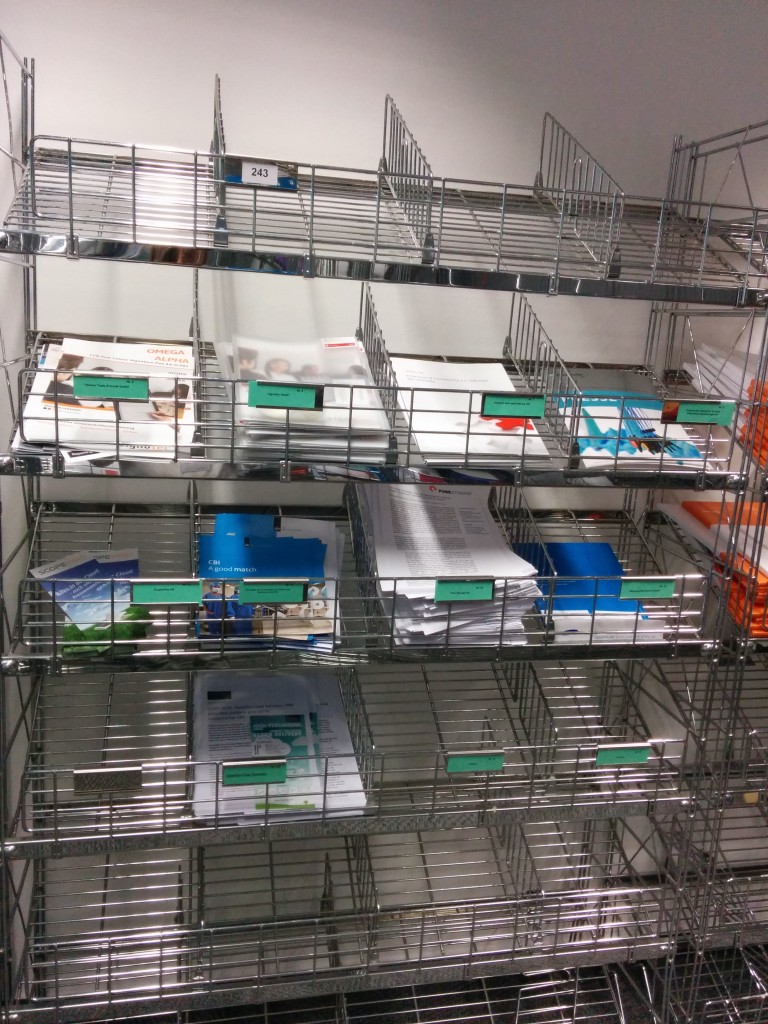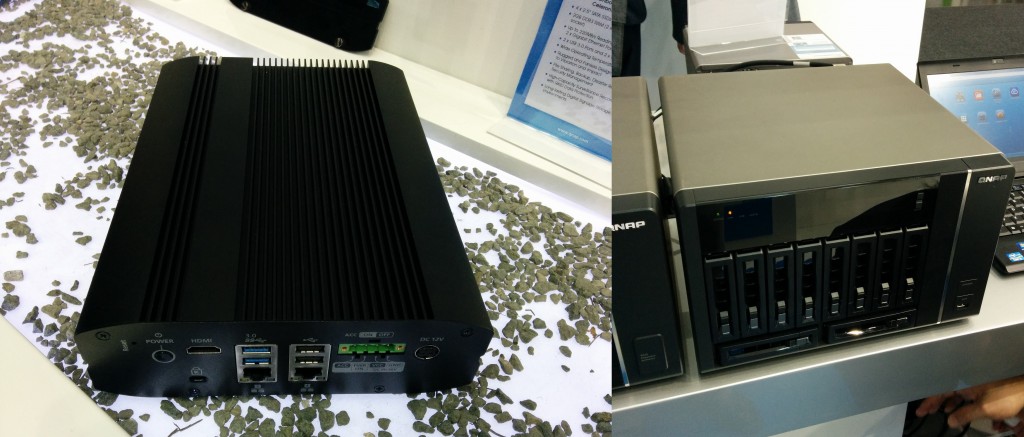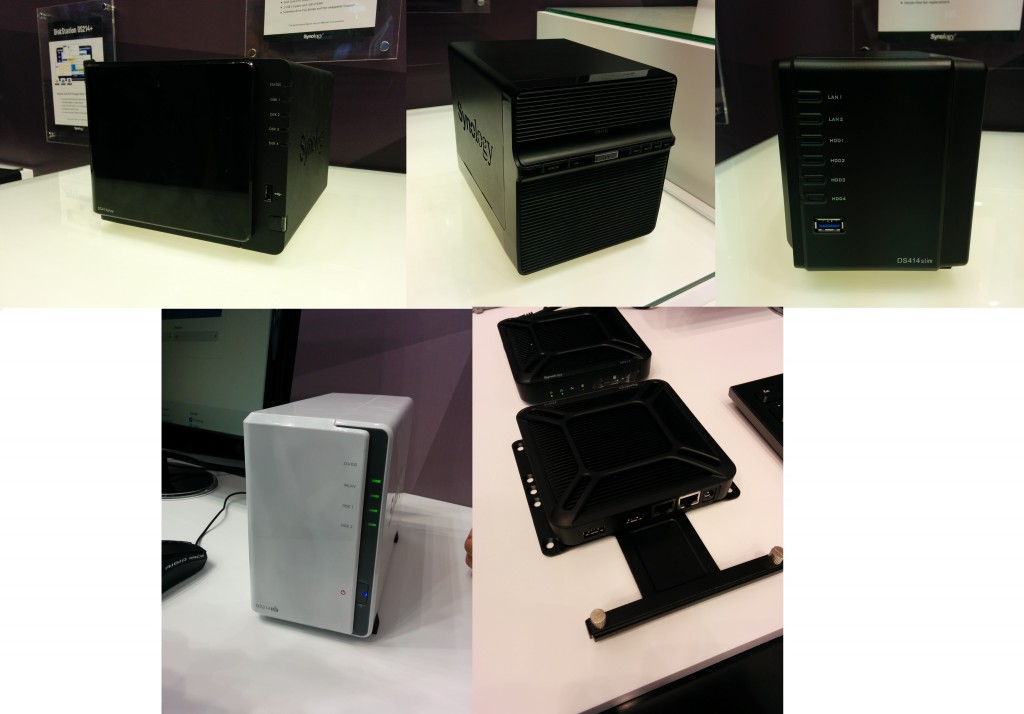SPECIAL REPORT on CeBIT 2014: Still Struggles
210,000 visitors, down 75,000 from last year
By Corentin Béchade | March 19, 2014 at 2:18 pmThe latest StorageNewsletter.com‘s CeBIT review of 2010 highlighted one thing: the international IT expo was slowly dying. In 2014 it would be easy to copy and paste most of the conclusions from our 2010 report.
Lot of empty racks in press center
The show is continuing on its downward path and struggles with exhibitors and visitors attendance. If the numbers from last year are to be trusted (and the CeBIT is sometimes known for cheating a bit with numbers), it attracted 4,100 exhibitors for roughly 285,000 visitors (official website). Figures for the 2014 edition are not so dazzling, the number of visitors dropped to 210,000. Record attendance at the CeBIT was in 2001 and registered a record 849,252 visitors. Last year Frank Pörschmann, managing board member, Deutsche Messe said that the aim for the show was to focus more on quality rather than quantity. Mission accomplished ! The times when you had to fight for your share of the wifi in the press room are now well over and the restaurants on the fair ground have never been so quiet and circulation on the aisles of halls never been so easy.
It is no surprise that StorageNewsletter.com stopped going to the CeBIT for three years, the show kept on shrinking space-wise and time-wise to reach only four days. Even the yearly catalog weighing tradition showed a drastic decrease, 313 grams this year. It was 3,210 grams in 2002, ten times more.
But the facts and figures of this year’s exhibition hide another reality: some of the major players of the industry were absent, and the booth size of many companies was reduced to a bare minimum. Many big storage firms were only present through distributor booths, sharing the space with several others. EMC for example stopped having its own booth as early as 2006. The CeBIT has now became an exposition where there is very little to see for end users and very few products announcements. More than half of the companies present at the exhibition were there to find resellers and to demo products they announced earlier in the year. Not exactly a dream place for novelty-seeker.
The absence of big players is mainly due to the growing trend of individual brand events. To occupy media space, companies that can afford it organize their own events, even if these tend to draw less people. They are beneficial because they can create their own buzz around their brand, avoiding therefore to be lost in the flood of CeBIT. What can also explain the defection is the fierce competition the Hannover fair has to face. With shows like Mobile World Congress, CES earlier in the year and NAB to come, many companies preferred specialized events.
NAS Being King
The giant hall 2 was, as usual, the place where most of the big companies were exhibiting. Of the few products announcement made at CeBIT, many came in the form of new NAS hardware, most notably from Qnap and Synology.
The former one unveiled on the first day of the show its new line of Turbo NAS, storage expansion and its beta software QTS 4.1
The IS-4000 Pro is an industrial grade NAS with dual-core CPU, and 1GbE plug, 4GB of DDR3 RAM and 4 hot swappable 2.5-inch HDD and SSD compatible enclosures, sadly not tool-less. It also has two USB 3.0 rear ports in the back and two USB 2.0 ports in the front. It is touted as shock resistant, a good addition but probably not absolutely essential in a 1.11kg (2.45 lbs) NAS.
The product will be available at the end of this month in Europe and America at 720€ ($999 if currency rates apply.)
Also available at the end of this month, for an MSRP of $3,000, the TS-EC1080 Pro is the latest addition in the company’s Turbo NAS business series. It boasts a quad-core Intel 3.4GHz processor, 8GB of RAM (expandable to 32GB) three USB 3.0 and six USB 2.0 ports and can support up to 40TB of raw capacity.
Synology had its fair share of new hardware too. But contrarily to Qnap, the manufacturer probably rushed a bit to present its new hardware for the CeBIT, as none of the new products on shelves had any release date, price or fixed specs.
Three products were in beta: the DS414slim, a small form-factor NAS with four 2.5 inch bays for HDDs and SSDs; the DS414J, the first of the J series to boast USB 3.0 compatibility and the 414play designed for entertainment with 1080p video transcoding on the fly and dual core CPU.
Two others were more in the ‘drawing board’ phase: the DS214 Air can act as a NAS with wireless capabilities and as a wifi router and is compatible with 4G LTE and wifi USB dongle; and the EDS 14 is a USB station with two USB 3.0 port and a SD card slot. Design of these products are susceptible to change.
Buffalo, all the way in the hall 15 (for resellers and journalist only), also unveiled some new products:
-
The Linkstation 441: a 4-bay NAS with no price and no release date announced
-
And the MiniStation Air, a wireless HDD that can also be used as an external battery for smartphone or tablet. Again no precise date or price
Re-imagining the data center?
One of the few truly innovative idea encountered at CeBIT did not came from any of the big players and wasn’t an end-user front facing product. It came from A*Star, an R&D storage institute in Sinpapore.
The organization’s mission is to update the architecture of the datacenter that hasn’t evolved these past years. So, using hybrid drive and non-volatile memory like STT-MRAM in data center, it claimed that they can achieve 9x times faster operation than traditional solution. And the CloudSec cloud gateway technology can provide encryption for Cinder volume storage.
X-IO Tries to Conquer the World
The former Seagate division was at CeBIT this year to continue on its media quest.
The company hasn’t made much noise since its inception, but roughly 9 to 12 months ago it decided to occupy more media space and to be more present in the industry to raise customer’s awareness in the company.
EMEA solutions development director Gavin McLaughlin touted that his company’s storage arrays had been road-tested long enough to claim a 0.1% failure rate with its disks and 99% data space usage without slowdown with a lifespan of ten years and 3 to 4 times the performance of standard solution.
But the company could find itself in a risky market, if the lifespan of their devices is as they claim, then to keep itself afloat it needs to constantly find new customers due to the absence of revenue stream other than sells, contrarily to company selling maintenance contract and guaranteeing solution for five years in the best cases.
Software
-
Qnap unveiled its beta version of QTS 4.1. Final version is said to come in few weeks
-
Synology demoed its DSM 5.0 with emphasis on cloud storage and third-party cloud integration
-
Novastor will unveil its v16 on May 16, it will include a virtual dashboard which allows to manage virtual and physical environment from one place
-
OwnCloud released it v6 with design improvements and more granular control over files accessing
CeBIT 2015 will be held from March 16 to the 20th, in Hannover as usual.
Again, the conclusion of our 2010 report sounds very familiar: the fair is still taking place over a 4-day course but taking into account the steady decrease in size, exhibitors and visitors numbers, next year exhibition could be interesting to watch but probably not for the reasons organizers would want to.
















 Subscribe to our free daily newsletter
Subscribe to our free daily newsletter

